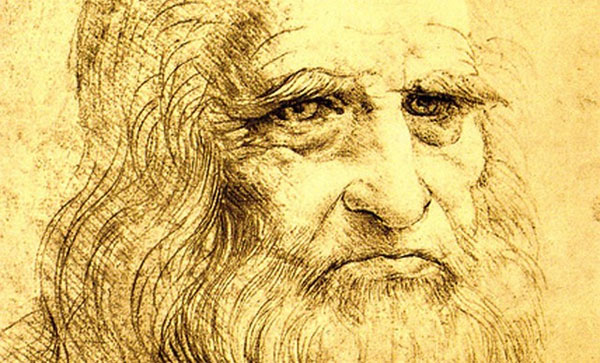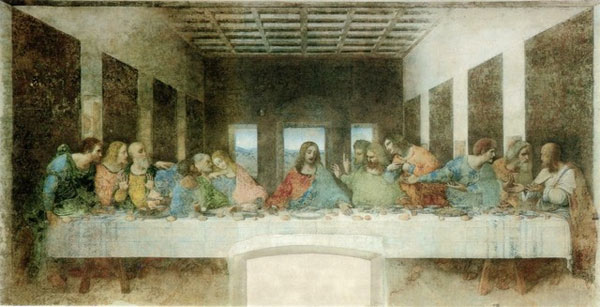Leonardo da Vinci and secrets not everyone knows
Leonardo da Vinci, a genius, a great inventor in human history, and moreover, he is the source of many controversies that are still controversial. The Da Vinci Code is one of the most famous examples of legends and legends surrounding this character, however, that is not all.
It has been several hundred years since Da Vinci's era, and many things are now simply impossible to verify.
Let's take a look at some of the mysteries surrounding this character in the article below:
Leonardo - Heretic
According to many authors of historical novels, Da Vinci is a heretic. The most obvious evidence of this hypothesis is probably hidden in the " Last Party , " a work that many believe Da Vinci expressed his own faith in Christ's marriage to Mary Magdalene. This woman is identified through an image of an apostle with the features of a woman and sitting on the right side of Jesus.

Leonardo Da Vinci
In addition, there is other evidence to support this hypothesis: the fact that Da Vinci, unintentionally or intentionally, lacks a glass of wine, the symbol of the Eucharistic celebration, along with the presence of a bizarre hand - the hand does not belong to anyone in the painting holding a knife.
So what is the truth? In fact, the " Last Party" painting, the fresco that was adorned at the monastery of Santa Maria delle Grazie in Milano, Italy, was inspired by Da Vinci from John's Gospel, and the blessing. This syllable does not mention any Eucharistic wine or any Eucharistic celebration. In addition, the knife hand belongs to Saint Peter (this detail is made clear after the painting has been restored to its most original state), and is used to refer to a passage in the Gospel, when Peter cut the ears of a High Priest.

And finally, the feminine details of the apostle sitting to the right of Jesus can be explained by the age of dress - when the young disciples of Jesus have to keep their hair long and behave in a way gentle, gentle.
Esoteric symbols
Not really a heretic, but certainly Da Vinci is not a religious person. It is very likely that Da Vinci was exposed to ideas that at the time were considered heretical, like the Platonic philosophy or Gnostic doctrine. Gnostic doctrine of worshiping goddess Sophia - the symbol of Leda's work has been lost. In some of the remaining copies, this goddess was seen as a "giant egg" , from which the human race was born.

Gnosticism also believes that Jesus has two forms of existence, the flesh has died on the cross, and the rest is only the soul. Another famous painting by Da Vinci, Virgin of the Rocks shows that the two children are very similar, perhaps the child often referred to as John the Baptist is actually the twin brother of Jesus, and His identity has been changed to create approval in the Christian community. Or perhaps, these two children are only one person. No one can say exactly which theory is the most accurate.
Is Da Vinci a member of Sion Monastery?
The 'Da Vinci Code' novel is a long adventure around the mysteries and legends of the Sion Monastery, who keeps the mysteries and discoveries of the Temple Knights. Dan Brown also repeatedly mentioned that many celebrities are likely members of this secret society, such as Isaac Newton, Victor Hugo, and of course Leonardo Da Vinci.

In fact, this organization was founded by a Frenchman named Pierre Plantard in 1956. Plantard named the Sion Monastery based on a hill above Annemasse, where he planned to build a secluded place . About the genealogy related to Jesus, this is essentially a genealogy reproduced from another genealogy found in 1915 in the United States by Harvey Spencer Lewis, who has a close relationship with Plantard. Plantard attempted to strengthen this genealogy in order to prove he was a descendant of the Merovingian lineage, the heir of a dynasty that disappeared in historical dust, thereby giving him more advantages and opportunities. on his political path. But that did not come true.
Technical writing reflection

Da Vinci possesses a rather 'weird' writing technique: he often writes right to left and from the last page up. This eccentricity is often interpreted as a personal arrangement of Da Vinci, to make his discoveries and works mysterious and difficult to understand for others. Those who gave him heresy were called this behavior of the devil, because of its unusual contrast.
In fact, this is Da Vinci's spontaneous writing . Modern neurology has shown, this is a common habit among left-handed people, this habit will arise in teenage years, and will be maintained if not corrected - as in the case of Da Vinci.
Who is really the Mona Lisa?
The identity of the woman in the world's most famous photograph, has long been a subject of controversy. Although the evidence is unclear, many authors believe that the woman belongs to the Sforza family, named Catherine, or her mother, Caterina Buti del Vacca, or even Bianca's sister. Some people think that this is Da Vinci's self-portrait, when computer analysis shows many similarities between two faces.

The most accepted theory so far is that this woman is Lisa Gherardini. She is the wife of Francesco del Giocondo (or Gionconda, coinciding with another name for the painting). Another question is more difficult to verify than the location of the painting. The bridge on the right seems to portray a bridge at Buriano, near Arezzo, but most likely this is just a setting Da Vinci built on his imagination.
What remains?
Da Vinci's tomb has ceased to exist, and no one knows where his bones are. After his death, he was buried at Saint Florentin church in Amboise, France. But by 1802, due to the impact of time, and especially the destruction caused by the French Revolutionary War, this church was destroyed. Bricks and stones from the tombs were later used to restore the church, and the remains were moved to various locations.
Until 1863, the French poet Arsene Houssaye found a nearly intact skeleton, with a bent hand and a very large skull. Not far away, he also discovered the fragments of a stone that had been erased nearly half, with the words read as EO DUS VINC. Is it Da Vinci's name in Latin, LEONARDUS VINCIUS? At the same time, this remains were found in a castle located in Amboise, not far from where he was originally buried.
Perhaps, this question, as well as all the other questions around Leonardo Da Vinci's extraordinary life, will always be questions without answers.
- 5 extremely unknown secrets behind the paintings of genius Leonardo da Vinci
- Find out the descendant of the life of Leonardo da Vinci
- 4 giant 'treasures' of Leonardo Da Vinci: The solution after 500 hundred years
- Discover the secret talent of the great Leonardo da Vinci
- Hair fibers are expected to make history after 500 years Leonardo da Vinci died
- Effort to save Leonardo Da Vinci's self-portrait
- Memo book of Leonardo Da Vinci
- Scientists want to rebuild Leonardo da Vinci's genome
- Revealing the portrait of Leonardo da Vinci through an ancient 500-year-old painting
- Leonardo da Vinci has a sharp artistic eye due to vision problems
- After 500 years, MIT proved that the bridge design of Leonardo Da Vinci is extremely reasonable
- Why is Leonardo da Vinci sick and dead
 'Fine laughs' - Scary and painful torture in ancient times
'Fine laughs' - Scary and painful torture in ancient times The sequence of numbers 142857 of the Egyptian pyramids is known as the strangest number in the world - Why?
The sequence of numbers 142857 of the Egyptian pyramids is known as the strangest number in the world - Why? History of the iron
History of the iron What is alum?
What is alum?